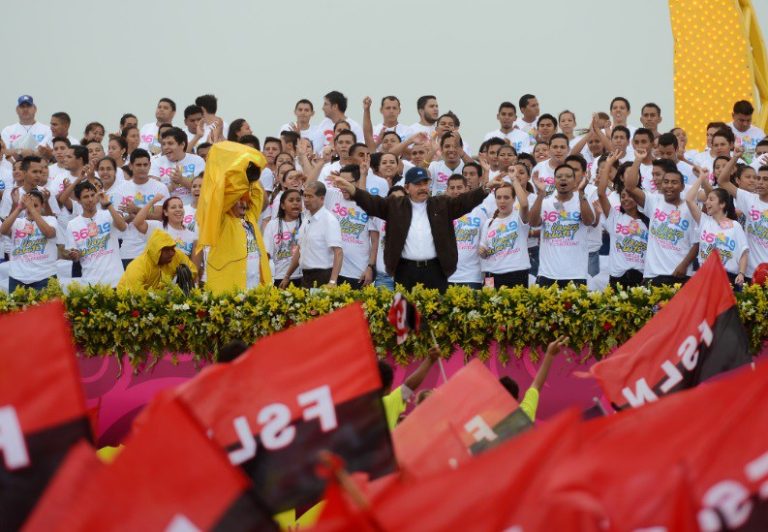7 de junio 2016

Ortega Grants Chinese Company a Huge Mining Concession

PUBLICIDAD 1M
PUBLICIDAD 4D
PUBLICIDAD 5D
“There is no Congress, but a meeting where everybody raises their hand because Ortega has thrown out anyone who escaped his leash,” says Baltodano

The Sandinista Congress unanimously ratified Commander Daniel Ortega’s seventh presidential candidacy with their hands raised high. They also authorized him to select his running mate as well as to the list of candidates to the National Assembly and Central American Parliament, for the general elections set for November 6.
The event, which was held in absolute secrecy, played out with no new surprises at the old Olof Palme party facility. Ortega delivered his anti-imperialist speech and refused independent election observers the chance to be present at the elections.
For at least three former FSLN members who once held distinguished positions within the party structure, the event held no surprises regarding the party’s “family-like” behavior which they feel is what Ortega has converted the Sandinista Front into: a family.
“I don’t know how they can call this a congress. It’s just a meeting where everyone raises their hand. You don’t even know who the congress delegates are (because) they’re all silent, nobody speaks. They’re not allowed to,” criticizes Monica Baltodano, a guerrilla leader and former legislator.
The revolutionary commander, Henry Ruiz, also known as “Modesto”, considers the party congress nothing more than “a formality which they have to fulfil as a political party because the Supreme Electoral Council requires it.” However, Ruiz argues that this is seriously lacking in necessary political mechanisms and opportunities to encourage any kind of debate.
Founded in 1961, the Sandinista National Liberation Front (FSLN) led the popular uprising which overthrew Somoza’s dictatorship in 1979 and five years later, in 1984, it turned to the ballot box and won the general elections, with Ortega as their President. Five presidential elections have taken place since then and the FSLN hasn’t put up any other candidate for the presidential elections.
Tellez thinks that today’s FSLN is no longer a revolutionary party and is merely “a political device in the hands of a family in power.”
Neither does Ortega let anyone run against him for the FSLN leadership. In 1994, Henry Ruiz agreed to challenge Ortega to be General Secretary. The attempt made by one of the nine revolutionary commanders and leader of the Sandinista guerrilla in the mountains was unsuccessful. Years later, when Ortega began negotiating a pact with the liberal leader Arnoldo Aleman, “Modesto” left the party.
Ruiz states that “the Sandinista Front wasn’t conceived democratically, but under the conditions of an underground and head-on struggle against Somoza’s dictatorship and as a result, it had a political-military structure, a vertical hierarchy.”
However, after they lost the elections in 1990, the party needed to reassess itself and to initiate a democratization process, which, according to Tellez, Ortega was against.
“By the mid-90s, Daniel Ortega had already managed to impose himself in the Sandinista Front. He was able to do this because of two things: One, because he had the power of being the Front’s most important public figure. And secondly, by employing the well-known strategy of creating a campaign against anybody who didn’t agree with him and labelling them: a traitor, sell-out, CIA spy, capitalist spy, international social-democrat spy, etc.,” Tellez revealed in 2013, in an interview published by Envio Magazine.
Now a historian, she believes that “Ortega has led the Sandinista Front completely away from its previous goal to transform society and has instead converted it into a political model which follows and acts just like Somoza’s dictatorship used to.” Tellez adds: “What the Sandinista Front has experienced isn’t really a process of involution. It’s a collapse.”
On the other hand, Baltodano, author of the four volume “Memoria de la Lucha Sandinista” (Memories of the Sandinista struggle), concludes that “it’s really sad that so many deaths and so much fighting have only led to the current state of the FSLN,” light years from its original objectives.
“In reality, the Sandinista Front no longer exists,” she argues, “what we have now is Ortega and Rosario Murillo’s political regime which controls everything down the political ladder. The FSLN isn’t even an organization anymore because it no longer has the proceedings of one. What we see time and time again is that as soon as somebody escapes Ortega’s leash, they’re expelled from the party.”
This article has been translated from Spanish by Havana Times.
Read the original version here.
Archivado como:
PUBLICIDAD 3M
Periodista. Desde 2003 ha trabajado en medios tradicionales y digitales.
PUBLICIDAD 3D